Financial Accounting Principles, Stakeholders, and Statements Report
VerifiedAdded on 2020/12/18
|26
|4436
|180
Report
AI Summary
This report provides a comprehensive overview of financial accounting principles, focusing on their purpose and application. It explores the core concepts, including the importance of financial accounting in recording and summarizing transactions, as well as the preparation of financial statements such as the income statement and balance sheet. The report highlights the significance of generally accepted accounting principles (GAAP) and their role in ensuring the accuracy and reliability of financial information for stakeholders. Furthermore, the report delves into the analysis of internal and external stakeholders, detailing their interests and influence on business decisions. It includes practical examples like journal entries, ledgers, trial balance, profit and loss accounts, balance sheets, depreciation methods, and bank reconciliation statements. The report also examines the differences between financial statements prepared by sole traders and limited companies, along with control accounts and their role in financial accounting.
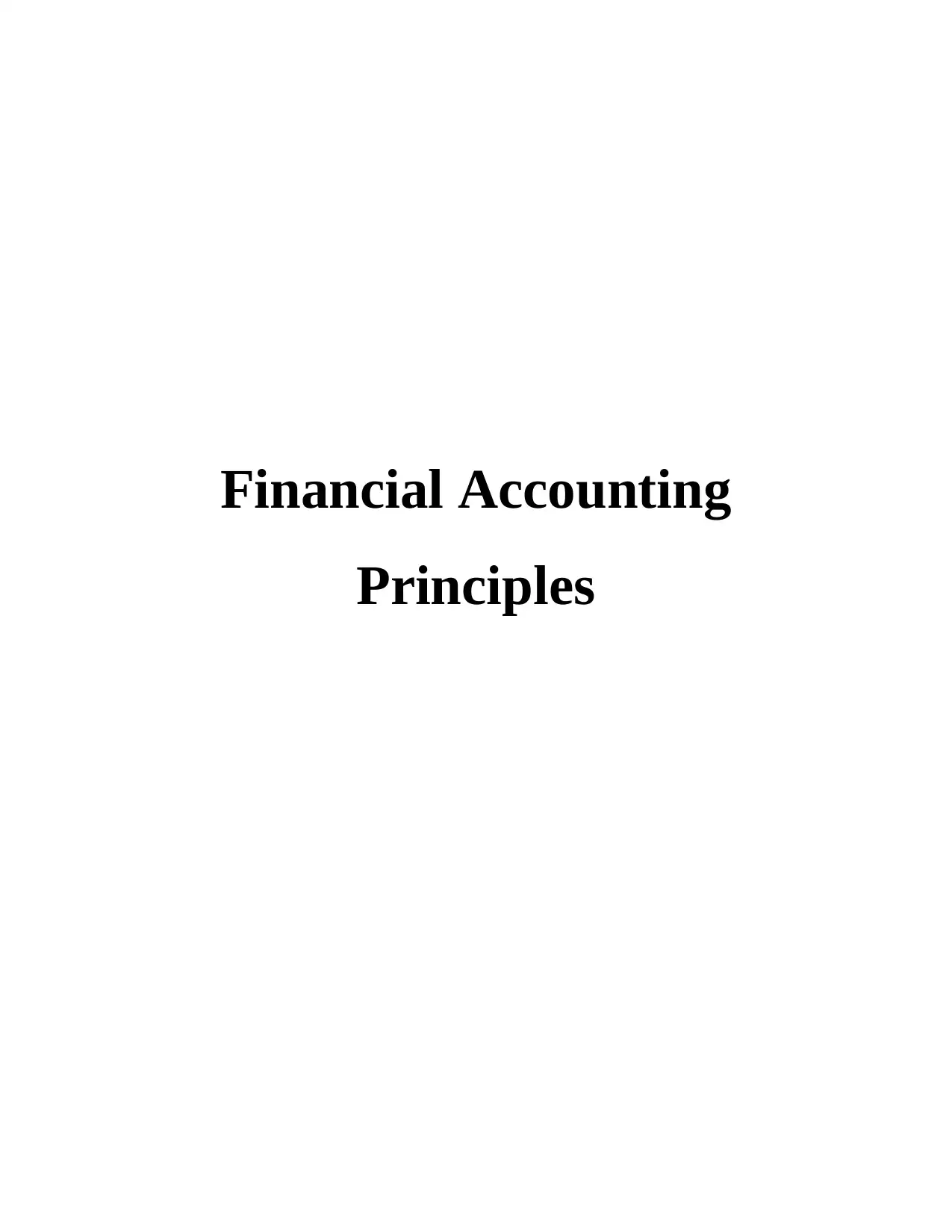
Financial Accounting
Principles
Principles
Paraphrase This Document
Need a fresh take? Get an instant paraphrase of this document with our AI Paraphraser
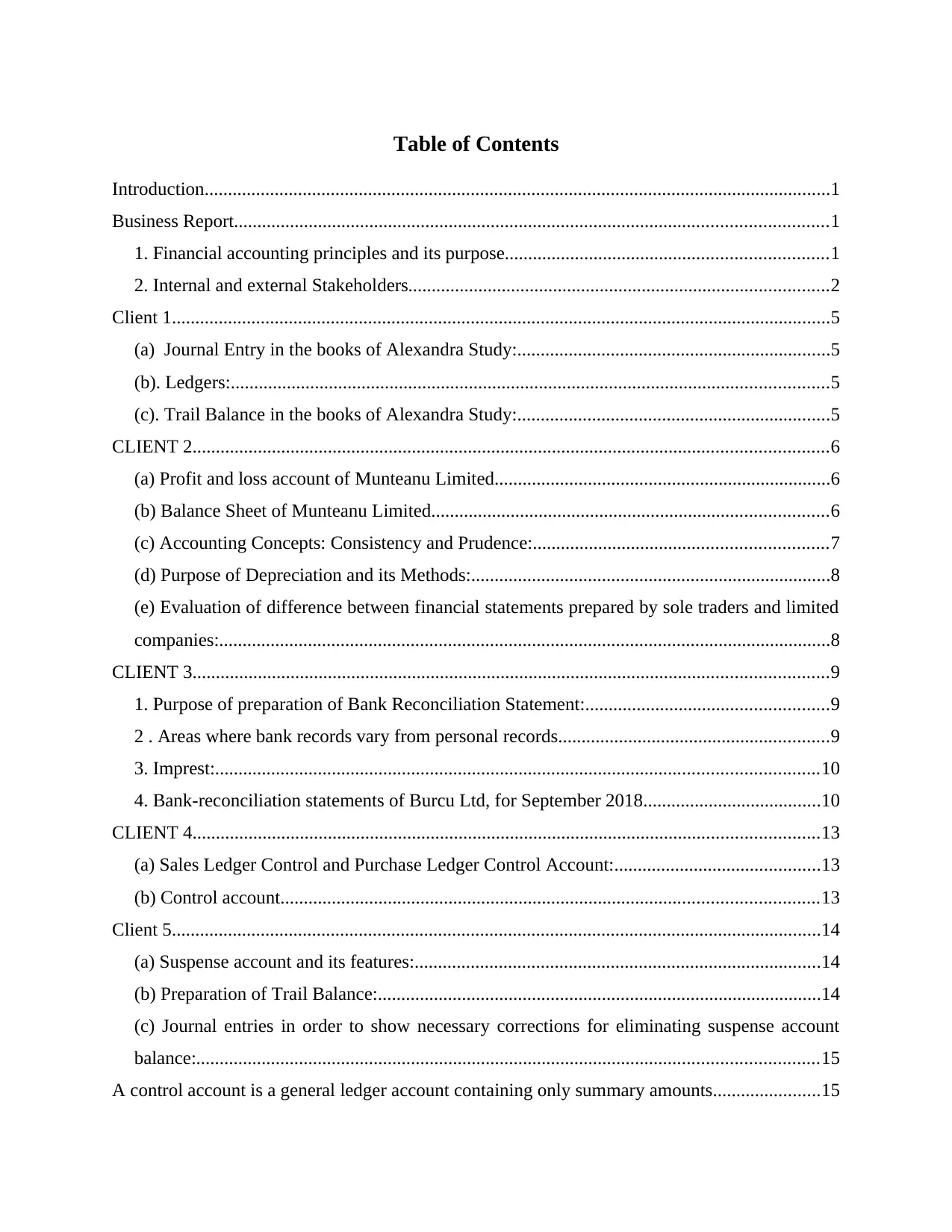
Table of Contents
Introduction......................................................................................................................................1
Business Report...............................................................................................................................1
1. Financial accounting principles and its purpose.....................................................................1
2. Internal and external Stakeholders..........................................................................................2
Client 1.............................................................................................................................................5
(a) Journal Entry in the books of Alexandra Study:...................................................................5
(b). Ledgers:................................................................................................................................5
(c). Trail Balance in the books of Alexandra Study:...................................................................5
CLIENT 2........................................................................................................................................6
(a) Profit and loss account of Munteanu Limited........................................................................6
(b) Balance Sheet of Munteanu Limited.....................................................................................6
(c) Accounting Concepts: Consistency and Prudence:...............................................................7
(d) Purpose of Depreciation and its Methods:.............................................................................8
(e) Evaluation of difference between financial statements prepared by sole traders and limited
companies:...................................................................................................................................8
CLIENT 3........................................................................................................................................9
1. Purpose of preparation of Bank Reconciliation Statement:....................................................9
2 . Areas where bank records vary from personal records..........................................................9
3. Imprest:.................................................................................................................................10
4. Bank-reconciliation statements of Burcu Ltd, for September 2018......................................10
CLIENT 4......................................................................................................................................13
(a) Sales Ledger Control and Purchase Ledger Control Account:............................................13
(b) Control account...................................................................................................................13
Client 5...........................................................................................................................................14
(a) Suspense account and its features:.......................................................................................14
(b) Preparation of Trail Balance:...............................................................................................14
(c) Journal entries in order to show necessary corrections for eliminating suspense account
balance:.....................................................................................................................................15
A control account is a general ledger account containing only summary amounts.......................15
Introduction......................................................................................................................................1
Business Report...............................................................................................................................1
1. Financial accounting principles and its purpose.....................................................................1
2. Internal and external Stakeholders..........................................................................................2
Client 1.............................................................................................................................................5
(a) Journal Entry in the books of Alexandra Study:...................................................................5
(b). Ledgers:................................................................................................................................5
(c). Trail Balance in the books of Alexandra Study:...................................................................5
CLIENT 2........................................................................................................................................6
(a) Profit and loss account of Munteanu Limited........................................................................6
(b) Balance Sheet of Munteanu Limited.....................................................................................6
(c) Accounting Concepts: Consistency and Prudence:...............................................................7
(d) Purpose of Depreciation and its Methods:.............................................................................8
(e) Evaluation of difference between financial statements prepared by sole traders and limited
companies:...................................................................................................................................8
CLIENT 3........................................................................................................................................9
1. Purpose of preparation of Bank Reconciliation Statement:....................................................9
2 . Areas where bank records vary from personal records..........................................................9
3. Imprest:.................................................................................................................................10
4. Bank-reconciliation statements of Burcu Ltd, for September 2018......................................10
CLIENT 4......................................................................................................................................13
(a) Sales Ledger Control and Purchase Ledger Control Account:............................................13
(b) Control account...................................................................................................................13
Client 5...........................................................................................................................................14
(a) Suspense account and its features:.......................................................................................14
(b) Preparation of Trail Balance:...............................................................................................14
(c) Journal entries in order to show necessary corrections for eliminating suspense account
balance:.....................................................................................................................................15
A control account is a general ledger account containing only summary amounts.......................15
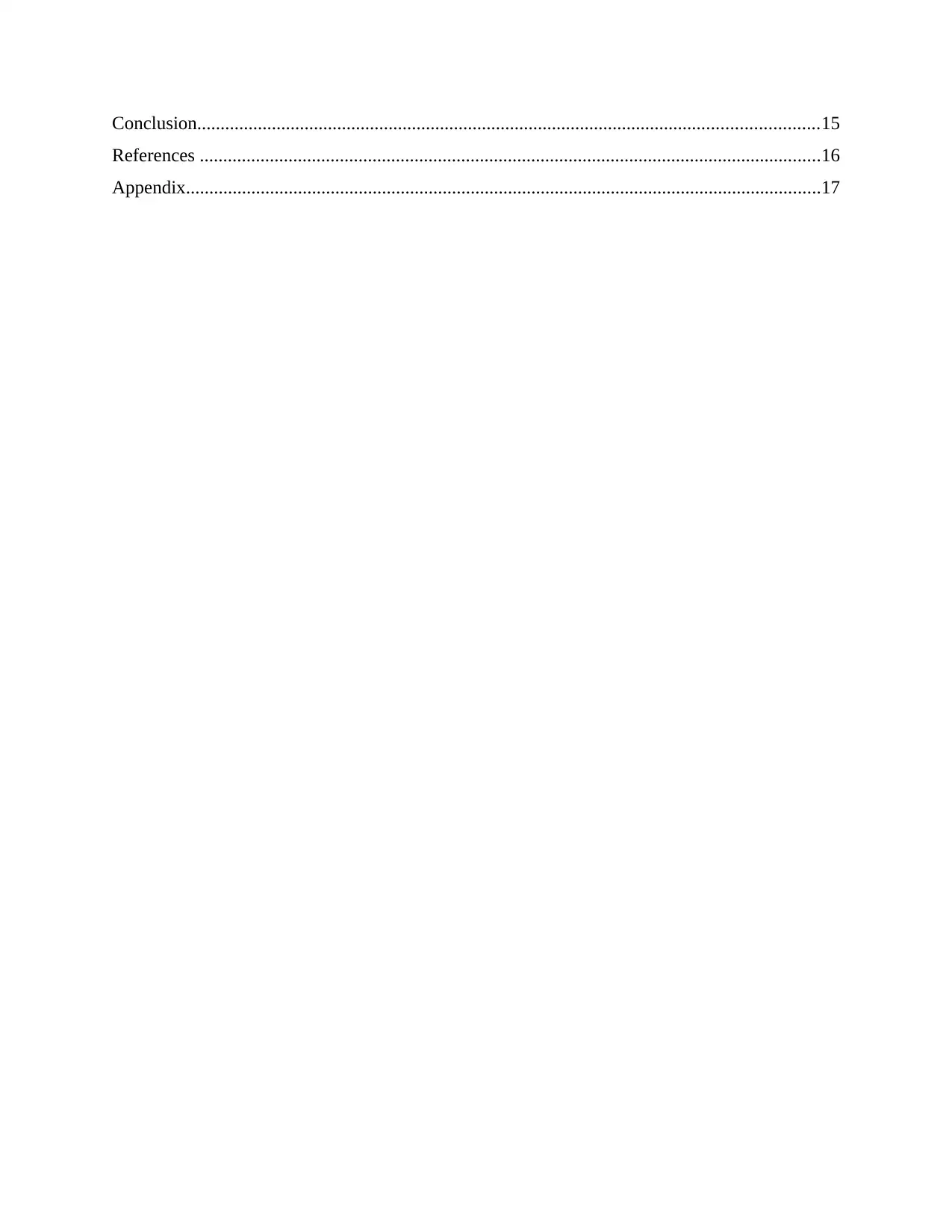
Conclusion.....................................................................................................................................15
References .....................................................................................................................................16
Appendix........................................................................................................................................17
References .....................................................................................................................................16
Appendix........................................................................................................................................17
⊘ This is a preview!⊘
Do you want full access?
Subscribe today to unlock all pages.

Trusted by 1+ million students worldwide
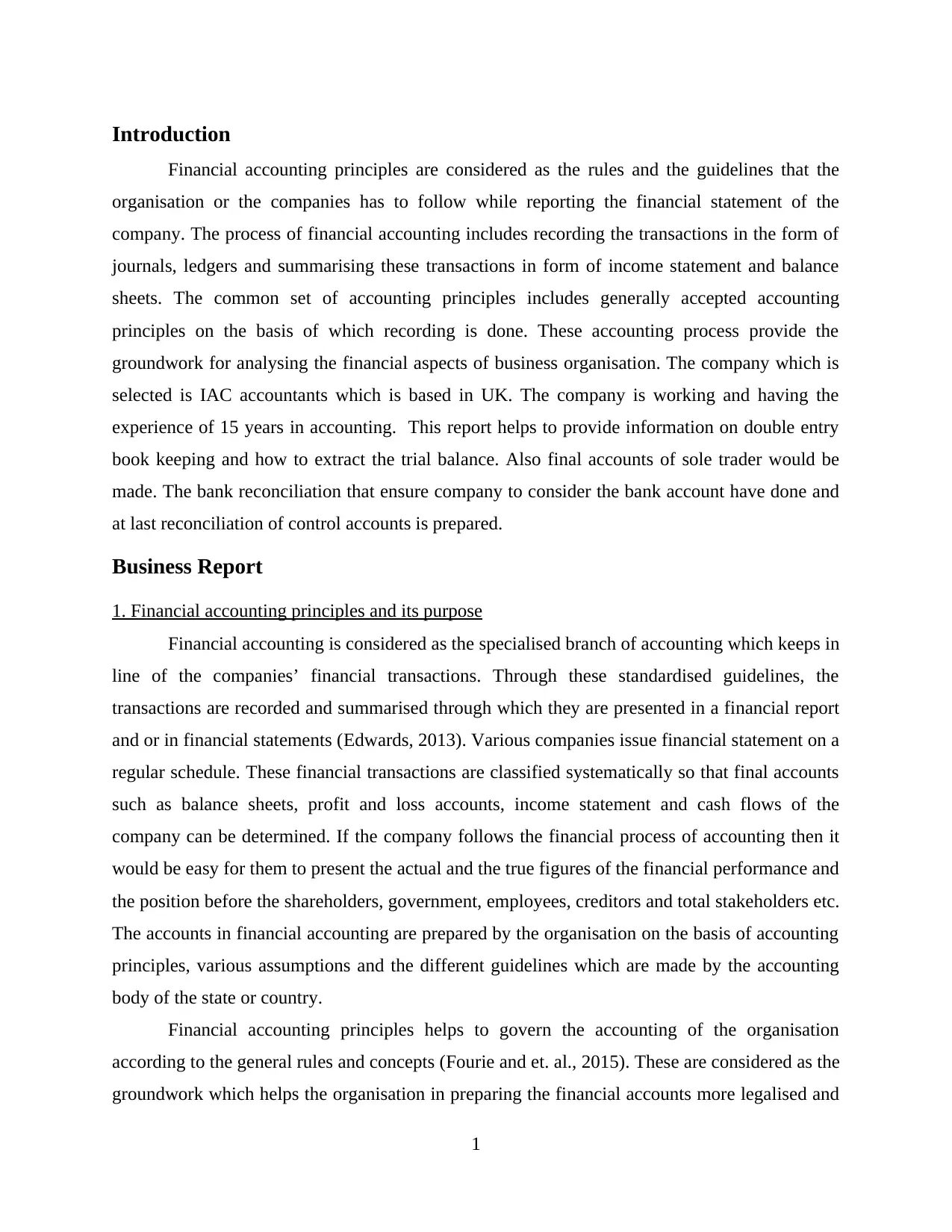
Introduction
Financial accounting principles are considered as the rules and the guidelines that the
organisation or the companies has to follow while reporting the financial statement of the
company. The process of financial accounting includes recording the transactions in the form of
journals, ledgers and summarising these transactions in form of income statement and balance
sheets. The common set of accounting principles includes generally accepted accounting
principles on the basis of which recording is done. These accounting process provide the
groundwork for analysing the financial aspects of business organisation. The company which is
selected is IAC accountants which is based in UK. The company is working and having the
experience of 15 years in accounting. This report helps to provide information on double entry
book keeping and how to extract the trial balance. Also final accounts of sole trader would be
made. The bank reconciliation that ensure company to consider the bank account have done and
at last reconciliation of control accounts is prepared.
Business Report
1. Financial accounting principles and its purpose
Financial accounting is considered as the specialised branch of accounting which keeps in
line of the companies’ financial transactions. Through these standardised guidelines, the
transactions are recorded and summarised through which they are presented in a financial report
and or in financial statements (Edwards, 2013). Various companies issue financial statement on a
regular schedule. These financial transactions are classified systematically so that final accounts
such as balance sheets, profit and loss accounts, income statement and cash flows of the
company can be determined. If the company follows the financial process of accounting then it
would be easy for them to present the actual and the true figures of the financial performance and
the position before the shareholders, government, employees, creditors and total stakeholders etc.
The accounts in financial accounting are prepared by the organisation on the basis of accounting
principles, various assumptions and the different guidelines which are made by the accounting
body of the state or country.
Financial accounting principles helps to govern the accounting of the organisation
according to the general rules and concepts (Fourie and et. al., 2015). These are considered as the
groundwork which helps the organisation in preparing the financial accounts more legalised and
1
Financial accounting principles are considered as the rules and the guidelines that the
organisation or the companies has to follow while reporting the financial statement of the
company. The process of financial accounting includes recording the transactions in the form of
journals, ledgers and summarising these transactions in form of income statement and balance
sheets. The common set of accounting principles includes generally accepted accounting
principles on the basis of which recording is done. These accounting process provide the
groundwork for analysing the financial aspects of business organisation. The company which is
selected is IAC accountants which is based in UK. The company is working and having the
experience of 15 years in accounting. This report helps to provide information on double entry
book keeping and how to extract the trial balance. Also final accounts of sole trader would be
made. The bank reconciliation that ensure company to consider the bank account have done and
at last reconciliation of control accounts is prepared.
Business Report
1. Financial accounting principles and its purpose
Financial accounting is considered as the specialised branch of accounting which keeps in
line of the companies’ financial transactions. Through these standardised guidelines, the
transactions are recorded and summarised through which they are presented in a financial report
and or in financial statements (Edwards, 2013). Various companies issue financial statement on a
regular schedule. These financial transactions are classified systematically so that final accounts
such as balance sheets, profit and loss accounts, income statement and cash flows of the
company can be determined. If the company follows the financial process of accounting then it
would be easy for them to present the actual and the true figures of the financial performance and
the position before the shareholders, government, employees, creditors and total stakeholders etc.
The accounts in financial accounting are prepared by the organisation on the basis of accounting
principles, various assumptions and the different guidelines which are made by the accounting
body of the state or country.
Financial accounting principles helps to govern the accounting of the organisation
according to the general rules and concepts (Fourie and et. al., 2015). These are considered as the
groundwork which helps the organisation in preparing the financial accounts more legalised and
1
Paraphrase This Document
Need a fresh take? Get an instant paraphrase of this document with our AI Paraphraser
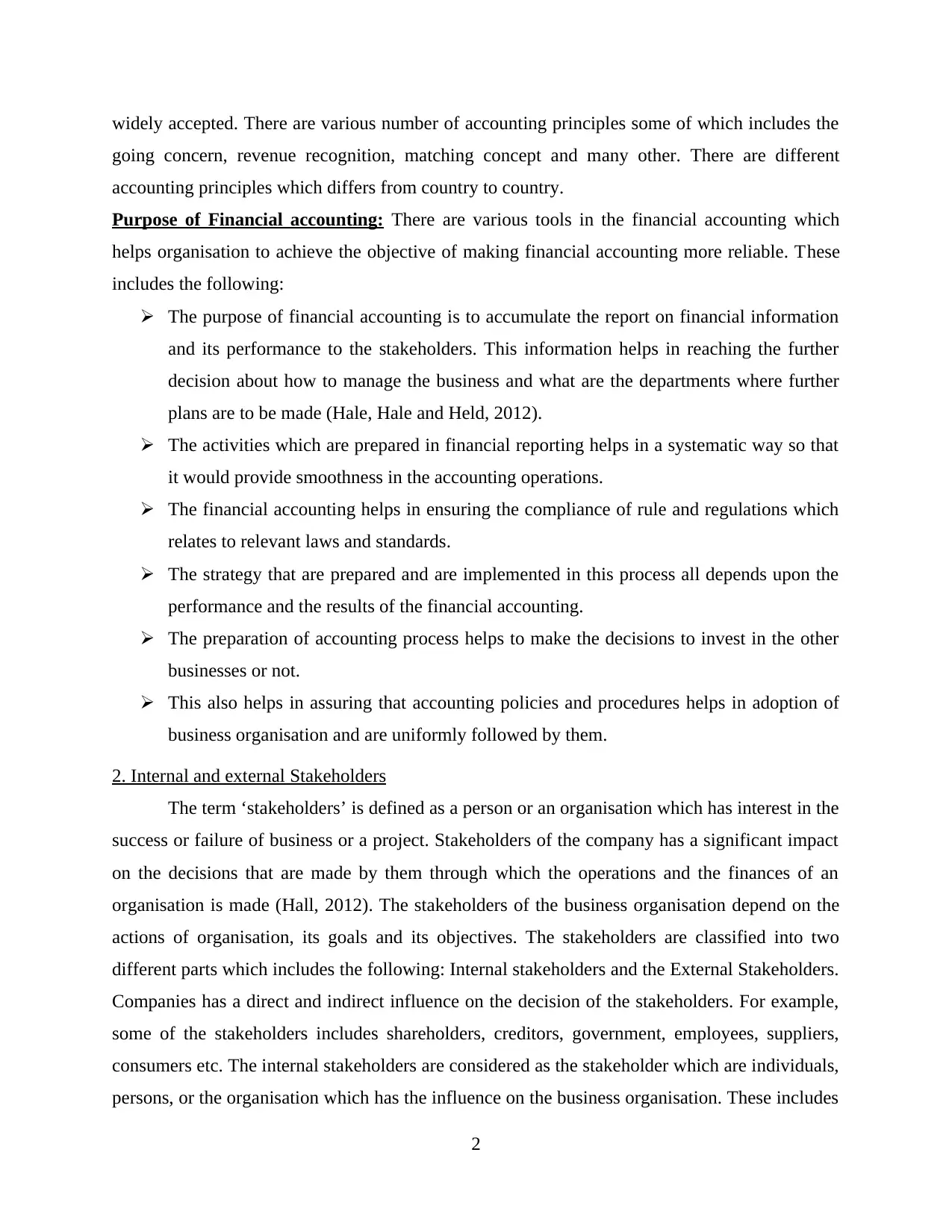
widely accepted. There are various number of accounting principles some of which includes the
going concern, revenue recognition, matching concept and many other. There are different
accounting principles which differs from country to country.
Purpose of Financial accounting: There are various tools in the financial accounting which
helps organisation to achieve the objective of making financial accounting more reliable. These
includes the following:
The purpose of financial accounting is to accumulate the report on financial information
and its performance to the stakeholders. This information helps in reaching the further
decision about how to manage the business and what are the departments where further
plans are to be made (Hale, Hale and Held, 2012).
The activities which are prepared in financial reporting helps in a systematic way so that
it would provide smoothness in the accounting operations.
The financial accounting helps in ensuring the compliance of rule and regulations which
relates to relevant laws and standards.
The strategy that are prepared and are implemented in this process all depends upon the
performance and the results of the financial accounting.
The preparation of accounting process helps to make the decisions to invest in the other
businesses or not.
This also helps in assuring that accounting policies and procedures helps in adoption of
business organisation and are uniformly followed by them.
2. Internal and external Stakeholders
The term ‘stakeholders’ is defined as a person or an organisation which has interest in the
success or failure of business or a project. Stakeholders of the company has a significant impact
on the decisions that are made by them through which the operations and the finances of an
organisation is made (Hall, 2012). The stakeholders of the business organisation depend on the
actions of organisation, its goals and its objectives. The stakeholders are classified into two
different parts which includes the following: Internal stakeholders and the External Stakeholders.
Companies has a direct and indirect influence on the decision of the stakeholders. For example,
some of the stakeholders includes shareholders, creditors, government, employees, suppliers,
consumers etc. The internal stakeholders are considered as the stakeholder which are individuals,
persons, or the organisation which has the influence on the business organisation. These includes
2
going concern, revenue recognition, matching concept and many other. There are different
accounting principles which differs from country to country.
Purpose of Financial accounting: There are various tools in the financial accounting which
helps organisation to achieve the objective of making financial accounting more reliable. These
includes the following:
The purpose of financial accounting is to accumulate the report on financial information
and its performance to the stakeholders. This information helps in reaching the further
decision about how to manage the business and what are the departments where further
plans are to be made (Hale, Hale and Held, 2012).
The activities which are prepared in financial reporting helps in a systematic way so that
it would provide smoothness in the accounting operations.
The financial accounting helps in ensuring the compliance of rule and regulations which
relates to relevant laws and standards.
The strategy that are prepared and are implemented in this process all depends upon the
performance and the results of the financial accounting.
The preparation of accounting process helps to make the decisions to invest in the other
businesses or not.
This also helps in assuring that accounting policies and procedures helps in adoption of
business organisation and are uniformly followed by them.
2. Internal and external Stakeholders
The term ‘stakeholders’ is defined as a person or an organisation which has interest in the
success or failure of business or a project. Stakeholders of the company has a significant impact
on the decisions that are made by them through which the operations and the finances of an
organisation is made (Hall, 2012). The stakeholders of the business organisation depend on the
actions of organisation, its goals and its objectives. The stakeholders are classified into two
different parts which includes the following: Internal stakeholders and the External Stakeholders.
Companies has a direct and indirect influence on the decision of the stakeholders. For example,
some of the stakeholders includes shareholders, creditors, government, employees, suppliers,
consumers etc. The internal stakeholders are considered as the stakeholder which are individuals,
persons, or the organisation which has the influence on the business organisation. These includes
2
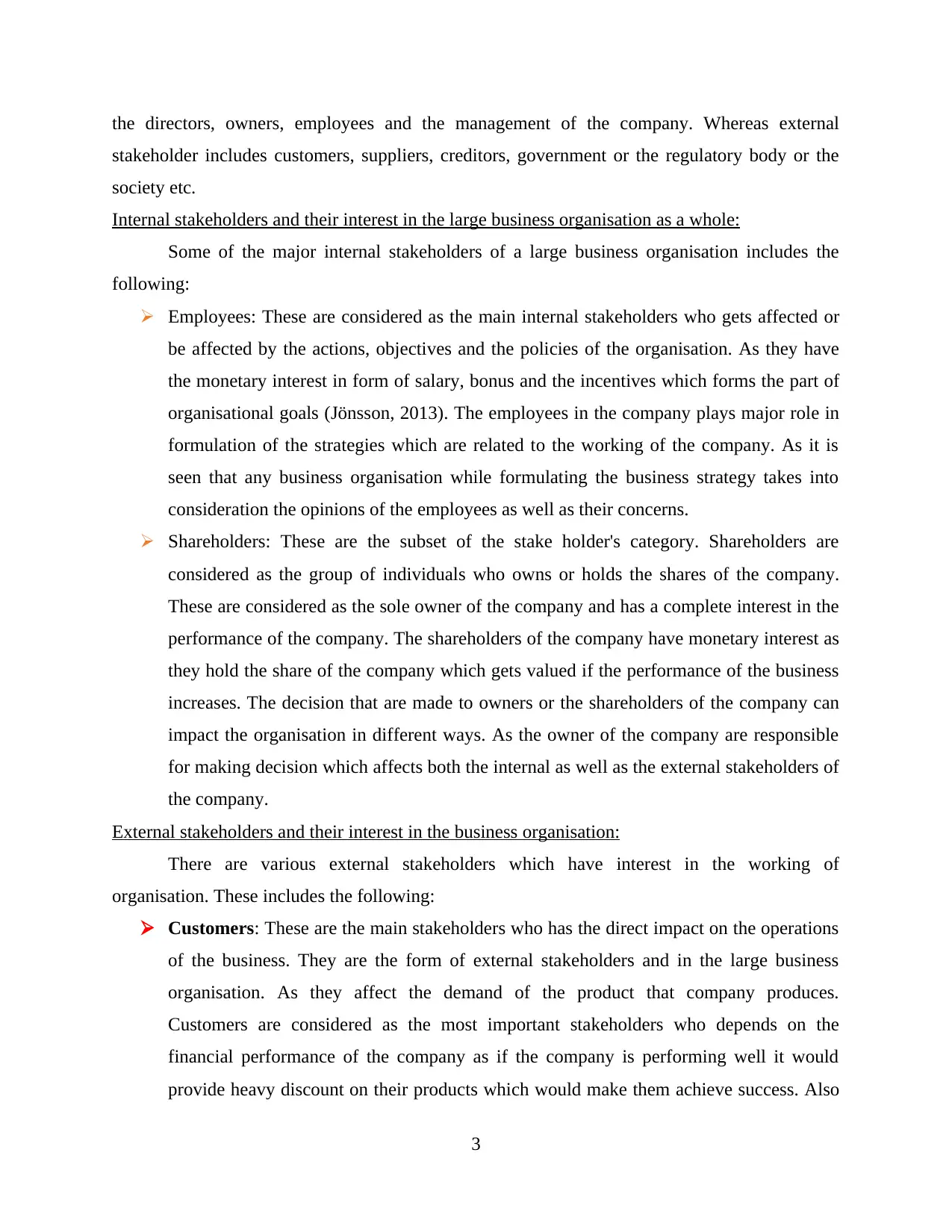
the directors, owners, employees and the management of the company. Whereas external
stakeholder includes customers, suppliers, creditors, government or the regulatory body or the
society etc.
Internal stakeholders and their interest in the large business organisation as a whole:
Some of the major internal stakeholders of a large business organisation includes the
following:
Employees: These are considered as the main internal stakeholders who gets affected or
be affected by the actions, objectives and the policies of the organisation. As they have
the monetary interest in form of salary, bonus and the incentives which forms the part of
organisational goals (Jönsson, 2013). The employees in the company plays major role in
formulation of the strategies which are related to the working of the company. As it is
seen that any business organisation while formulating the business strategy takes into
consideration the opinions of the employees as well as their concerns.
Shareholders: These are the subset of the stake holder's category. Shareholders are
considered as the group of individuals who owns or holds the shares of the company.
These are considered as the sole owner of the company and has a complete interest in the
performance of the company. The shareholders of the company have monetary interest as
they hold the share of the company which gets valued if the performance of the business
increases. The decision that are made to owners or the shareholders of the company can
impact the organisation in different ways. As the owner of the company are responsible
for making decision which affects both the internal as well as the external stakeholders of
the company.
External stakeholders and their interest in the business organisation:
There are various external stakeholders which have interest in the working of
organisation. These includes the following:
Customers: These are the main stakeholders who has the direct impact on the operations
of the business. They are the form of external stakeholders and in the large business
organisation. As they affect the demand of the product that company produces.
Customers are considered as the most important stakeholders who depends on the
financial performance of the company as if the company is performing well it would
provide heavy discount on their products which would make them achieve success. Also
3
stakeholder includes customers, suppliers, creditors, government or the regulatory body or the
society etc.
Internal stakeholders and their interest in the large business organisation as a whole:
Some of the major internal stakeholders of a large business organisation includes the
following:
Employees: These are considered as the main internal stakeholders who gets affected or
be affected by the actions, objectives and the policies of the organisation. As they have
the monetary interest in form of salary, bonus and the incentives which forms the part of
organisational goals (Jönsson, 2013). The employees in the company plays major role in
formulation of the strategies which are related to the working of the company. As it is
seen that any business organisation while formulating the business strategy takes into
consideration the opinions of the employees as well as their concerns.
Shareholders: These are the subset of the stake holder's category. Shareholders are
considered as the group of individuals who owns or holds the shares of the company.
These are considered as the sole owner of the company and has a complete interest in the
performance of the company. The shareholders of the company have monetary interest as
they hold the share of the company which gets valued if the performance of the business
increases. The decision that are made to owners or the shareholders of the company can
impact the organisation in different ways. As the owner of the company are responsible
for making decision which affects both the internal as well as the external stakeholders of
the company.
External stakeholders and their interest in the business organisation:
There are various external stakeholders which have interest in the working of
organisation. These includes the following:
Customers: These are the main stakeholders who has the direct impact on the operations
of the business. They are the form of external stakeholders and in the large business
organisation. As they affect the demand of the product that company produces.
Customers are considered as the most important stakeholders who depends on the
financial performance of the company as if the company is performing well it would
provide heavy discount on their products which would make them achieve success. Also
3
⊘ This is a preview!⊘
Do you want full access?
Subscribe today to unlock all pages.

Trusted by 1+ million students worldwide
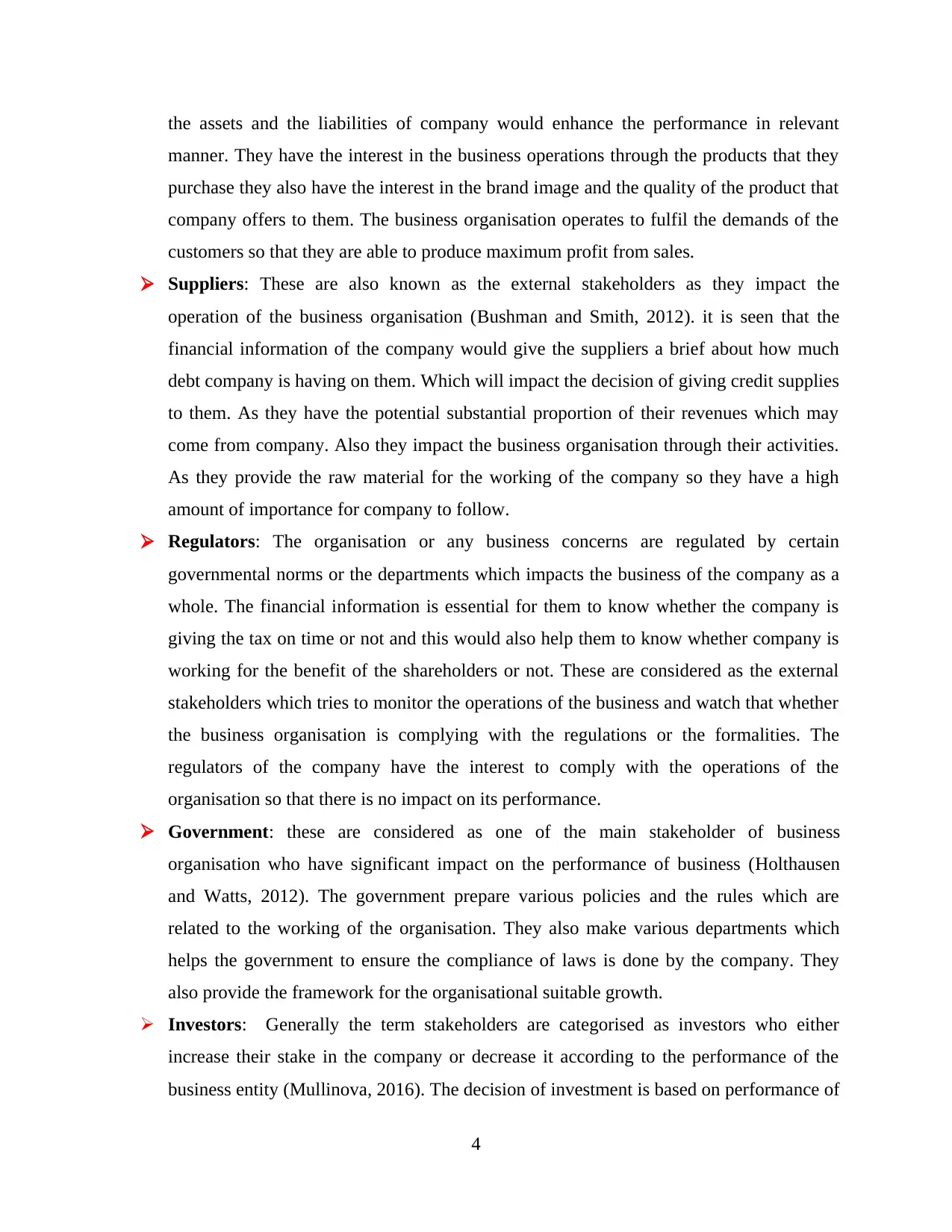
the assets and the liabilities of company would enhance the performance in relevant
manner. They have the interest in the business operations through the products that they
purchase they also have the interest in the brand image and the quality of the product that
company offers to them. The business organisation operates to fulfil the demands of the
customers so that they are able to produce maximum profit from sales.
Suppliers: These are also known as the external stakeholders as they impact the
operation of the business organisation (Bushman and Smith, 2012). it is seen that the
financial information of the company would give the suppliers a brief about how much
debt company is having on them. Which will impact the decision of giving credit supplies
to them. As they have the potential substantial proportion of their revenues which may
come from company. Also they impact the business organisation through their activities.
As they provide the raw material for the working of the company so they have a high
amount of importance for company to follow.
Regulators: The organisation or any business concerns are regulated by certain
governmental norms or the departments which impacts the business of the company as a
whole. The financial information is essential for them to know whether the company is
giving the tax on time or not and this would also help them to know whether company is
working for the benefit of the shareholders or not. These are considered as the external
stakeholders which tries to monitor the operations of the business and watch that whether
the business organisation is complying with the regulations or the formalities. The
regulators of the company have the interest to comply with the operations of the
organisation so that there is no impact on its performance.
Government: these are considered as one of the main stakeholder of business
organisation who have significant impact on the performance of business (Holthausen
and Watts, 2012). The government prepare various policies and the rules which are
related to the working of the organisation. They also make various departments which
helps the government to ensure the compliance of laws is done by the company. They
also provide the framework for the organisational suitable growth.
Investors: Generally the term stakeholders are categorised as investors who either
increase their stake in the company or decrease it according to the performance of the
business entity (Mullinova, 2016). The decision of investment is based on performance of
4
manner. They have the interest in the business operations through the products that they
purchase they also have the interest in the brand image and the quality of the product that
company offers to them. The business organisation operates to fulfil the demands of the
customers so that they are able to produce maximum profit from sales.
Suppliers: These are also known as the external stakeholders as they impact the
operation of the business organisation (Bushman and Smith, 2012). it is seen that the
financial information of the company would give the suppliers a brief about how much
debt company is having on them. Which will impact the decision of giving credit supplies
to them. As they have the potential substantial proportion of their revenues which may
come from company. Also they impact the business organisation through their activities.
As they provide the raw material for the working of the company so they have a high
amount of importance for company to follow.
Regulators: The organisation or any business concerns are regulated by certain
governmental norms or the departments which impacts the business of the company as a
whole. The financial information is essential for them to know whether the company is
giving the tax on time or not and this would also help them to know whether company is
working for the benefit of the shareholders or not. These are considered as the external
stakeholders which tries to monitor the operations of the business and watch that whether
the business organisation is complying with the regulations or the formalities. The
regulators of the company have the interest to comply with the operations of the
organisation so that there is no impact on its performance.
Government: these are considered as one of the main stakeholder of business
organisation who have significant impact on the performance of business (Holthausen
and Watts, 2012). The government prepare various policies and the rules which are
related to the working of the organisation. They also make various departments which
helps the government to ensure the compliance of laws is done by the company. They
also provide the framework for the organisational suitable growth.
Investors: Generally the term stakeholders are categorised as investors who either
increase their stake in the company or decrease it according to the performance of the
business entity (Mullinova, 2016). The decision of investment is based on performance of
4
Paraphrase This Document
Need a fresh take? Get an instant paraphrase of this document with our AI Paraphraser
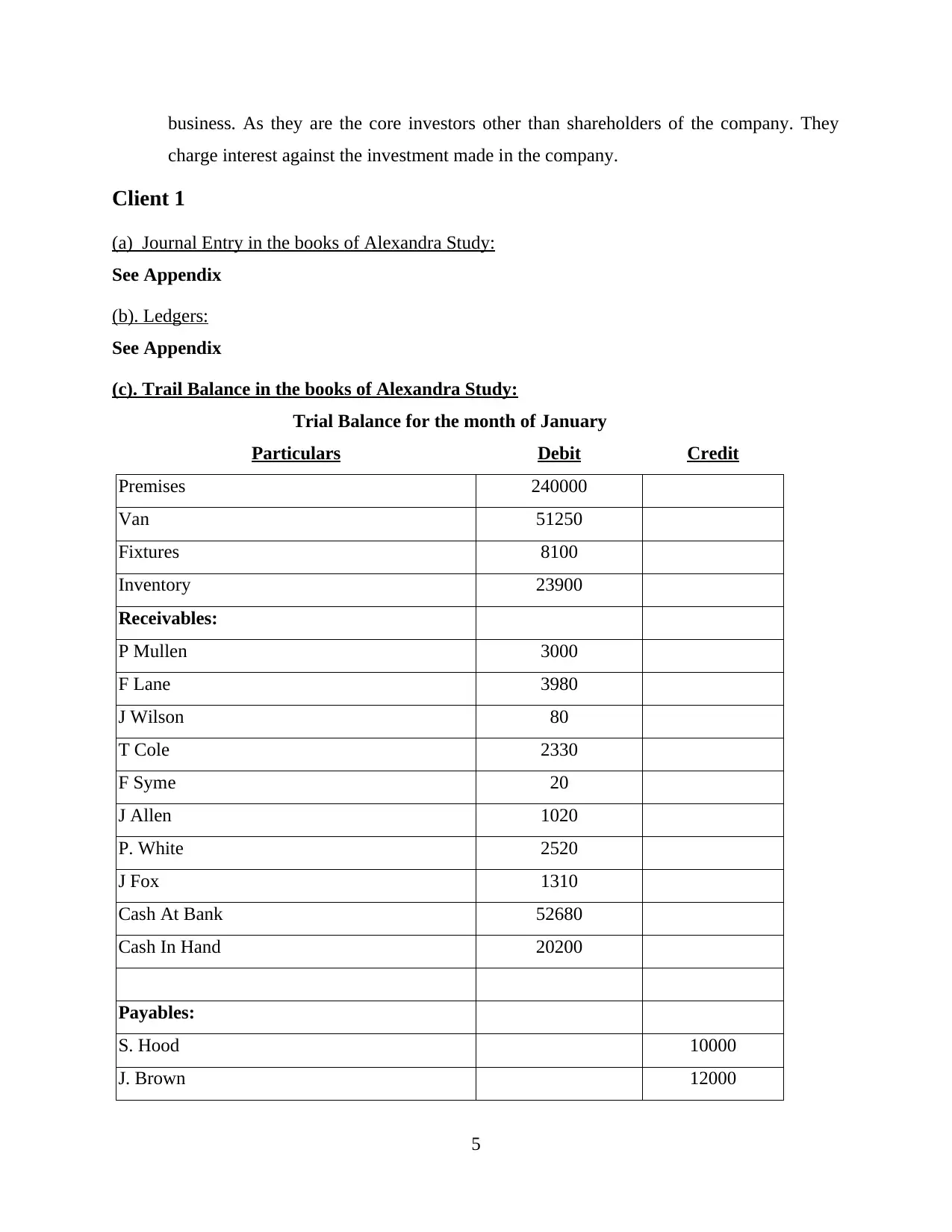
business. As they are the core investors other than shareholders of the company. They
charge interest against the investment made in the company.
Client 1
(a) Journal Entry in the books of Alexandra Study:
See Appendix
(b). Ledgers:
See Appendix
(c). Trail Balance in the books of Alexandra Study:
Trial Balance for the month of January
Particulars Debit Credit
Premises 240000
Van 51250
Fixtures 8100
Inventory 23900
Receivables:
P Mullen 3000
F Lane 3980
J Wilson 80
T Cole 2330
F Syme 20
J Allen 1020
P. White 2520
J Fox 1310
Cash At Bank 52680
Cash In Hand 20200
Payables:
S. Hood 10000
J. Brown 12000
5
charge interest against the investment made in the company.
Client 1
(a) Journal Entry in the books of Alexandra Study:
See Appendix
(b). Ledgers:
See Appendix
(c). Trail Balance in the books of Alexandra Study:
Trial Balance for the month of January
Particulars Debit Credit
Premises 240000
Van 51250
Fixtures 8100
Inventory 23900
Receivables:
P Mullen 3000
F Lane 3980
J Wilson 80
T Cole 2330
F Syme 20
J Allen 1020
P. White 2520
J Fox 1310
Cash At Bank 52680
Cash In Hand 20200
Payables:
S. Hood 10000
J. Brown 12000
5
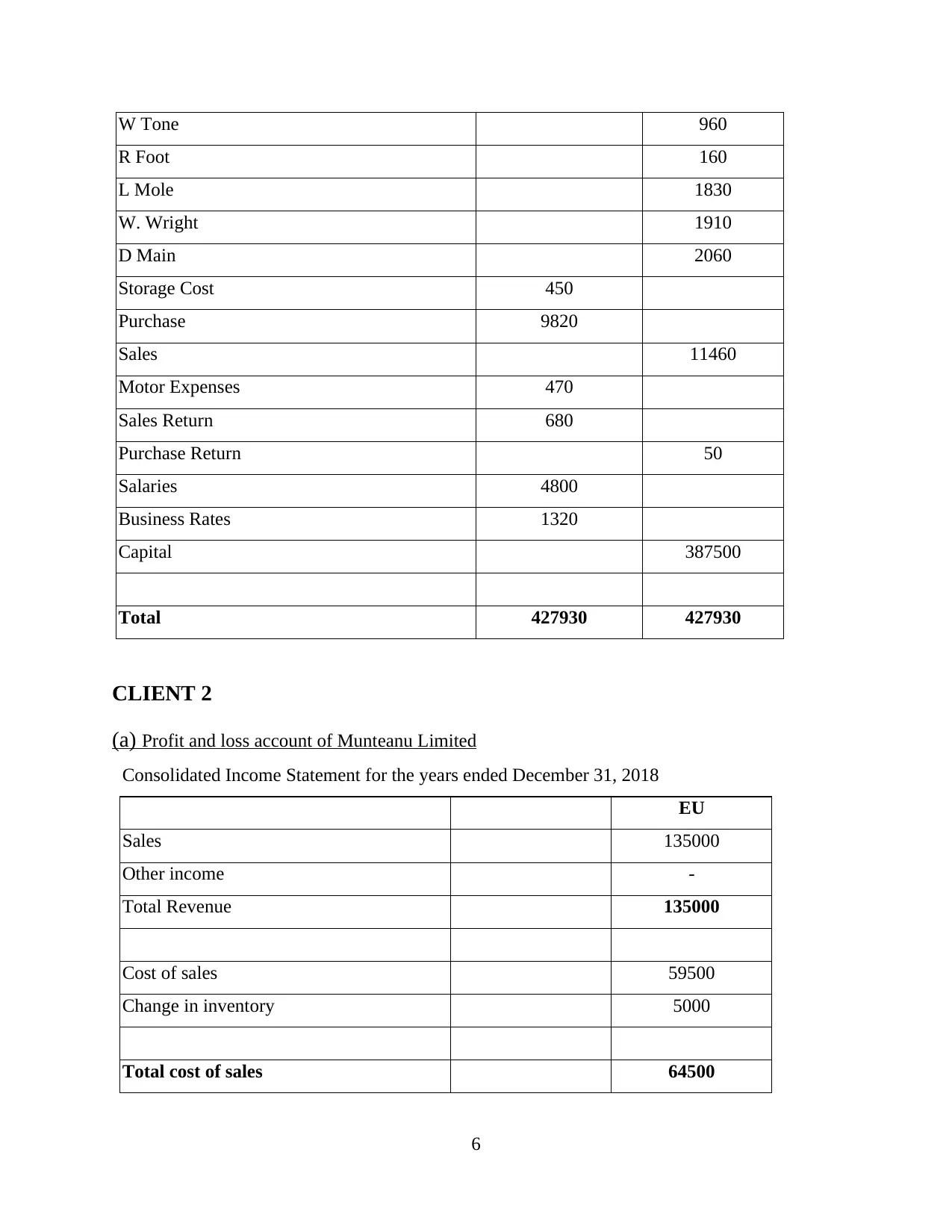
W Tone 960
R Foot 160
L Mole 1830
W. Wright 1910
D Main 2060
Storage Cost 450
Purchase 9820
Sales 11460
Motor Expenses 470
Sales Return 680
Purchase Return 50
Salaries 4800
Business Rates 1320
Capital 387500
Total 427930 427930
CLIENT 2
(a) Profit and loss account of Munteanu Limited
Consolidated Income Statement for the years ended December 31, 2018
EU
Sales 135000
Other income -
Total Revenue 135000
Cost of sales 59500
Change in inventory 5000
Total cost of sales 64500
6
R Foot 160
L Mole 1830
W. Wright 1910
D Main 2060
Storage Cost 450
Purchase 9820
Sales 11460
Motor Expenses 470
Sales Return 680
Purchase Return 50
Salaries 4800
Business Rates 1320
Capital 387500
Total 427930 427930
CLIENT 2
(a) Profit and loss account of Munteanu Limited
Consolidated Income Statement for the years ended December 31, 2018
EU
Sales 135000
Other income -
Total Revenue 135000
Cost of sales 59500
Change in inventory 5000
Total cost of sales 64500
6
⊘ This is a preview!⊘
Do you want full access?
Subscribe today to unlock all pages.

Trusted by 1+ million students worldwide
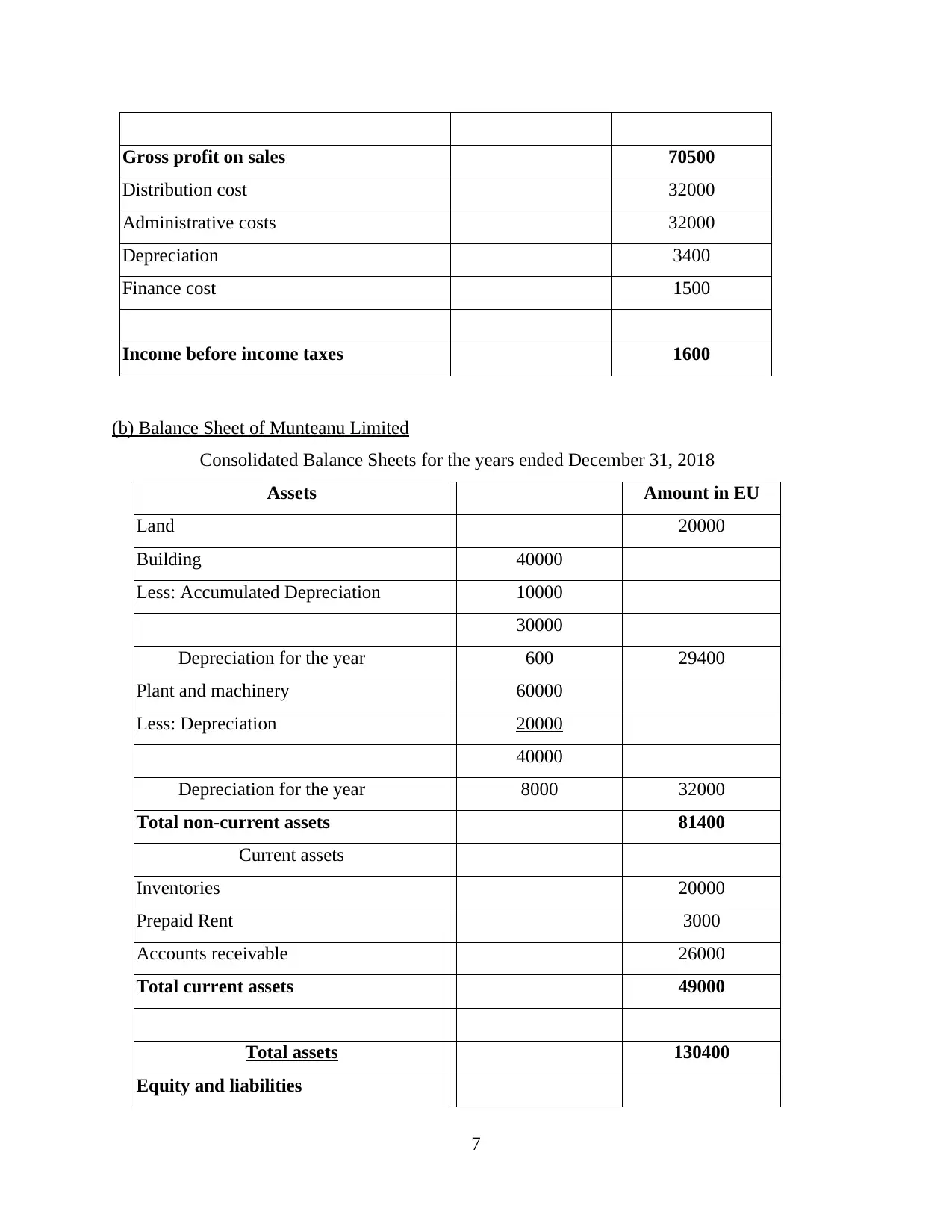
Gross profit on sales 70500
Distribution cost 32000
Administrative costs 32000
Depreciation 3400
Finance cost 1500
Income before income taxes 1600
(b) Balance Sheet of Munteanu Limited
Consolidated Balance Sheets for the years ended December 31, 2018
Assets Amount in EU
Land 20000
Building 40000
Less: Accumulated Depreciation 10000
30000
Depreciation for the year 600 29400
Plant and machinery 60000
Less: Depreciation 20000
40000
Depreciation for the year 8000 32000
Total non-current assets 81400
Current assets
Inventories 20000
Prepaid Rent 3000
Accounts receivable 26000
Total current assets 49000
Total assets 130400
Equity and liabilities
7
Distribution cost 32000
Administrative costs 32000
Depreciation 3400
Finance cost 1500
Income before income taxes 1600
(b) Balance Sheet of Munteanu Limited
Consolidated Balance Sheets for the years ended December 31, 2018
Assets Amount in EU
Land 20000
Building 40000
Less: Accumulated Depreciation 10000
30000
Depreciation for the year 600 29400
Plant and machinery 60000
Less: Depreciation 20000
40000
Depreciation for the year 8000 32000
Total non-current assets 81400
Current assets
Inventories 20000
Prepaid Rent 3000
Accounts receivable 26000
Total current assets 49000
Total assets 130400
Equity and liabilities
7
Paraphrase This Document
Need a fresh take? Get an instant paraphrase of this document with our AI Paraphraser
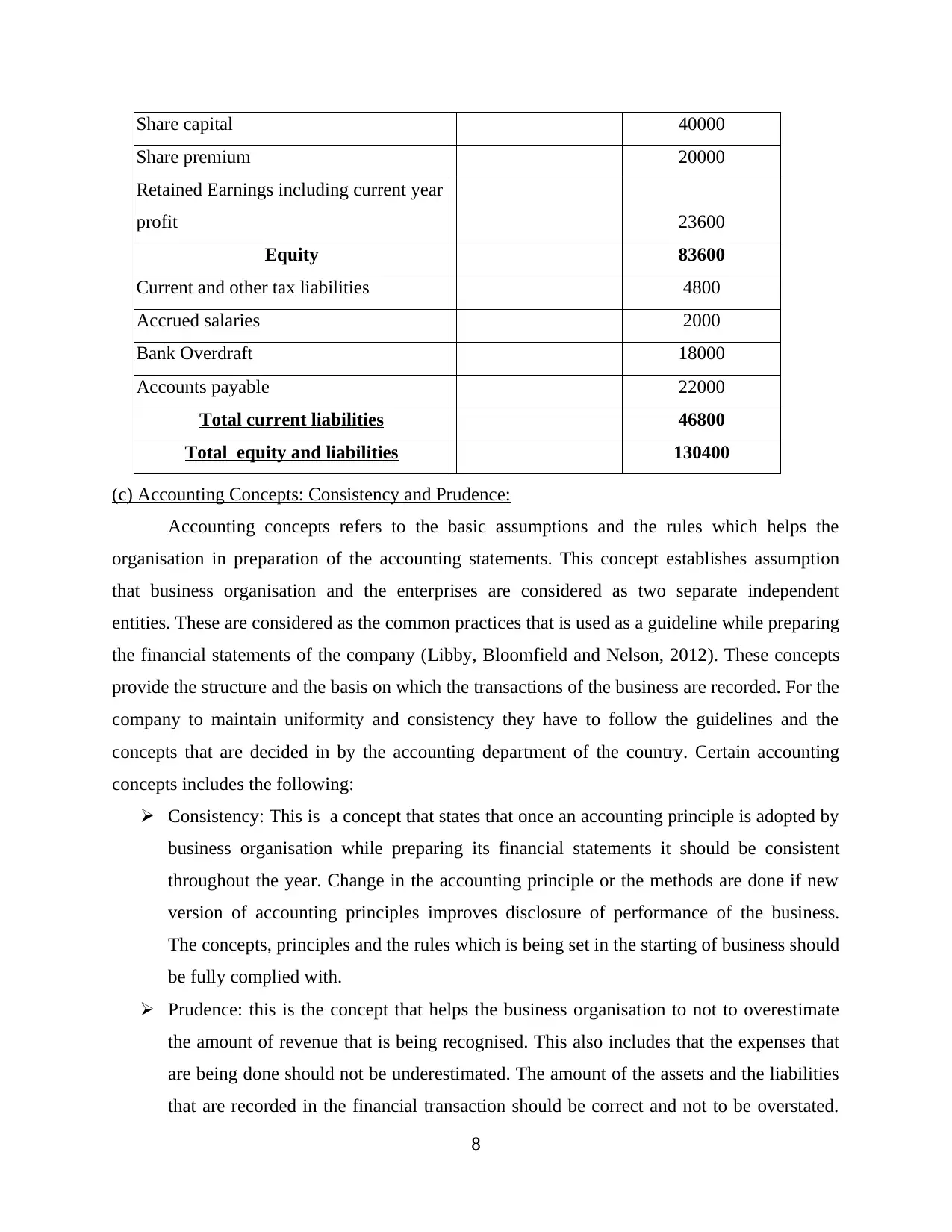
Share capital 40000
Share premium 20000
Retained Earnings including current year
profit 23600
Equity 83600
Current and other tax liabilities 4800
Accrued salaries 2000
Bank Overdraft 18000
Accounts payable 22000
Total current liabilities 46800
Total equity and liabilities 130400
(c) Accounting Concepts: Consistency and Prudence:
Accounting concepts refers to the basic assumptions and the rules which helps the
organisation in preparation of the accounting statements. This concept establishes assumption
that business organisation and the enterprises are considered as two separate independent
entities. These are considered as the common practices that is used as a guideline while preparing
the financial statements of the company (Libby, Bloomfield and Nelson, 2012). These concepts
provide the structure and the basis on which the transactions of the business are recorded. For the
company to maintain uniformity and consistency they have to follow the guidelines and the
concepts that are decided in by the accounting department of the country. Certain accounting
concepts includes the following:
Consistency: This is a concept that states that once an accounting principle is adopted by
business organisation while preparing its financial statements it should be consistent
throughout the year. Change in the accounting principle or the methods are done if new
version of accounting principles improves disclosure of performance of the business.
The concepts, principles and the rules which is being set in the starting of business should
be fully complied with.
Prudence: this is the concept that helps the business organisation to not to overestimate
the amount of revenue that is being recognised. This also includes that the expenses that
are being done should not be underestimated. The amount of the assets and the liabilities
that are recorded in the financial transaction should be correct and not to be overstated.
8
Share premium 20000
Retained Earnings including current year
profit 23600
Equity 83600
Current and other tax liabilities 4800
Accrued salaries 2000
Bank Overdraft 18000
Accounts payable 22000
Total current liabilities 46800
Total equity and liabilities 130400
(c) Accounting Concepts: Consistency and Prudence:
Accounting concepts refers to the basic assumptions and the rules which helps the
organisation in preparation of the accounting statements. This concept establishes assumption
that business organisation and the enterprises are considered as two separate independent
entities. These are considered as the common practices that is used as a guideline while preparing
the financial statements of the company (Libby, Bloomfield and Nelson, 2012). These concepts
provide the structure and the basis on which the transactions of the business are recorded. For the
company to maintain uniformity and consistency they have to follow the guidelines and the
concepts that are decided in by the accounting department of the country. Certain accounting
concepts includes the following:
Consistency: This is a concept that states that once an accounting principle is adopted by
business organisation while preparing its financial statements it should be consistent
throughout the year. Change in the accounting principle or the methods are done if new
version of accounting principles improves disclosure of performance of the business.
The concepts, principles and the rules which is being set in the starting of business should
be fully complied with.
Prudence: this is the concept that helps the business organisation to not to overestimate
the amount of revenue that is being recognised. This also includes that the expenses that
are being done should not be underestimated. The amount of the assets and the liabilities
that are recorded in the financial transaction should be correct and not to be overstated.
8
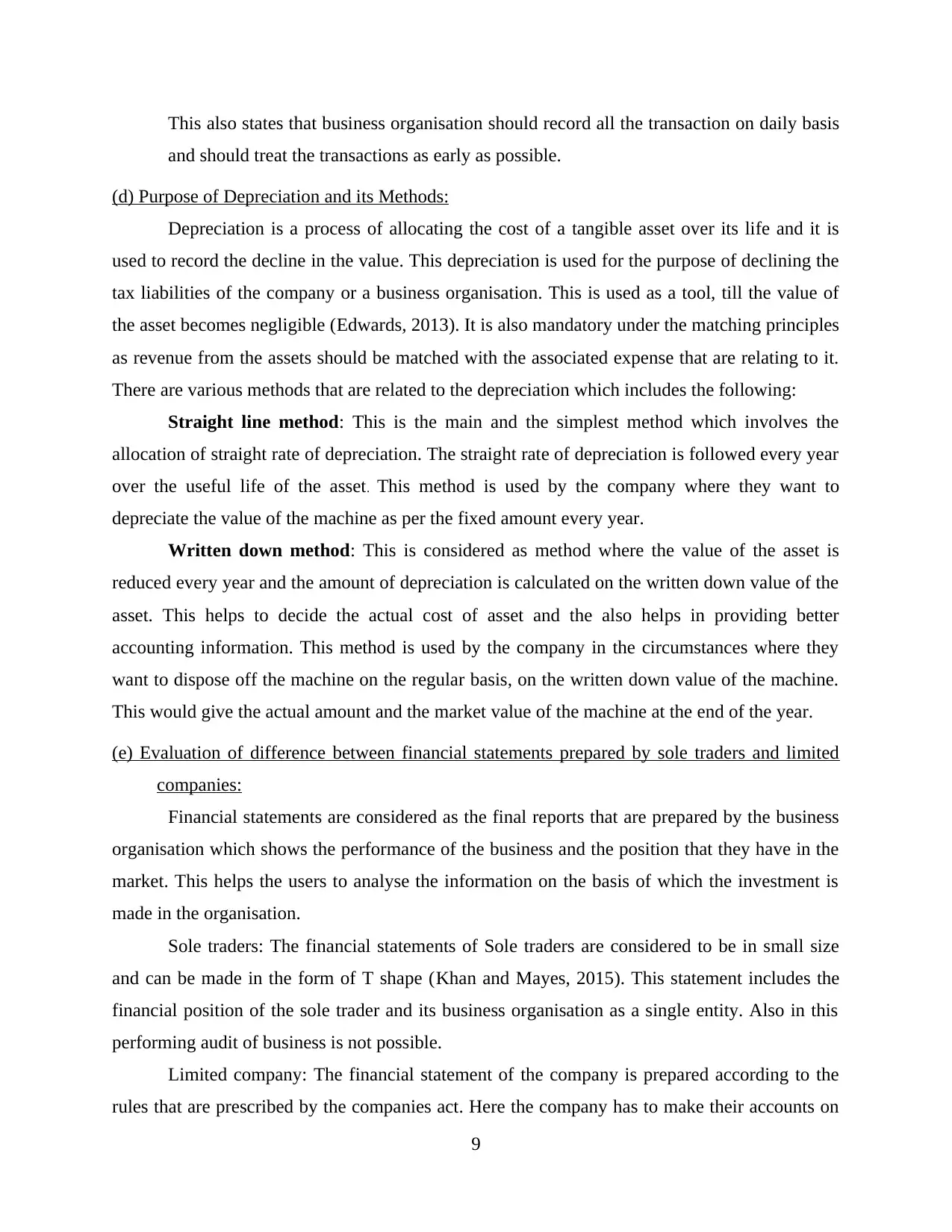
This also states that business organisation should record all the transaction on daily basis
and should treat the transactions as early as possible.
(d) Purpose of Depreciation and its Methods:
Depreciation is a process of allocating the cost of a tangible asset over its life and it is
used to record the decline in the value. This depreciation is used for the purpose of declining the
tax liabilities of the company or a business organisation. This is used as a tool, till the value of
the asset becomes negligible (Edwards, 2013). It is also mandatory under the matching principles
as revenue from the assets should be matched with the associated expense that are relating to it.
There are various methods that are related to the depreciation which includes the following:
Straight line method: This is the main and the simplest method which involves the
allocation of straight rate of depreciation. The straight rate of depreciation is followed every year
over the useful life of the asset. This method is used by the company where they want to
depreciate the value of the machine as per the fixed amount every year.
Written down method: This is considered as method where the value of the asset is
reduced every year and the amount of depreciation is calculated on the written down value of the
asset. This helps to decide the actual cost of asset and the also helps in providing better
accounting information. This method is used by the company in the circumstances where they
want to dispose off the machine on the regular basis, on the written down value of the machine.
This would give the actual amount and the market value of the machine at the end of the year.
(e) Evaluation of difference between financial statements prepared by sole traders and limited
companies:
Financial statements are considered as the final reports that are prepared by the business
organisation which shows the performance of the business and the position that they have in the
market. This helps the users to analyse the information on the basis of which the investment is
made in the organisation.
Sole traders: The financial statements of Sole traders are considered to be in small size
and can be made in the form of T shape (Khan and Mayes, 2015). This statement includes the
financial position of the sole trader and its business organisation as a single entity. Also in this
performing audit of business is not possible.
Limited company: The financial statement of the company is prepared according to the
rules that are prescribed by the companies act. Here the company has to make their accounts on
9
and should treat the transactions as early as possible.
(d) Purpose of Depreciation and its Methods:
Depreciation is a process of allocating the cost of a tangible asset over its life and it is
used to record the decline in the value. This depreciation is used for the purpose of declining the
tax liabilities of the company or a business organisation. This is used as a tool, till the value of
the asset becomes negligible (Edwards, 2013). It is also mandatory under the matching principles
as revenue from the assets should be matched with the associated expense that are relating to it.
There are various methods that are related to the depreciation which includes the following:
Straight line method: This is the main and the simplest method which involves the
allocation of straight rate of depreciation. The straight rate of depreciation is followed every year
over the useful life of the asset. This method is used by the company where they want to
depreciate the value of the machine as per the fixed amount every year.
Written down method: This is considered as method where the value of the asset is
reduced every year and the amount of depreciation is calculated on the written down value of the
asset. This helps to decide the actual cost of asset and the also helps in providing better
accounting information. This method is used by the company in the circumstances where they
want to dispose off the machine on the regular basis, on the written down value of the machine.
This would give the actual amount and the market value of the machine at the end of the year.
(e) Evaluation of difference between financial statements prepared by sole traders and limited
companies:
Financial statements are considered as the final reports that are prepared by the business
organisation which shows the performance of the business and the position that they have in the
market. This helps the users to analyse the information on the basis of which the investment is
made in the organisation.
Sole traders: The financial statements of Sole traders are considered to be in small size
and can be made in the form of T shape (Khan and Mayes, 2015). This statement includes the
financial position of the sole trader and its business organisation as a single entity. Also in this
performing audit of business is not possible.
Limited company: The financial statement of the company is prepared according to the
rules that are prescribed by the companies act. Here the company has to make their accounts on
9
⊘ This is a preview!⊘
Do you want full access?
Subscribe today to unlock all pages.

Trusted by 1+ million students worldwide
1 out of 26
Related Documents
Your All-in-One AI-Powered Toolkit for Academic Success.
+13062052269
info@desklib.com
Available 24*7 on WhatsApp / Email
![[object Object]](/_next/static/media/star-bottom.7253800d.svg)
Unlock your academic potential
Copyright © 2020–2025 A2Z Services. All Rights Reserved. Developed and managed by ZUCOL.





